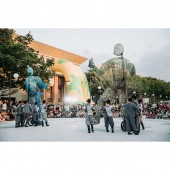Check-in Hsinchu City and Design Expo by BIAS Architects and Associates |
Home > Winners > #123053 |
 |
|
||||
| DESIGN DETAILS | |||||
| DESIGN NAME: Check-in Hsinchu PRIMARY FUNCTION: City and Design Expo INSPIRATION: The Expo program was developed in the context of an urban promotion campaign, and it was based on a socio-cultural investigation of the place. By researching Hsinchu city's background, BIAS found that a large portion of the local population moved in because of the flourishing Science Park. Unfortunately, this Park is socio-culturally segregated from the historical urban center. So, BIAS imagined a new narrative for the whole city, i.e., to reconsider the city itself as a 'material database' that registers both the old and the latest happenings. Through such a narrative, no matter the reason behind the participation in the city, everyone can join, and a hybrid living style can finally develop by integrating both the idea of memory and the idea of innovation. UNIQUE PROPERTIES / PROJECT DESCRIPTION: Taiwan Design Expo is an annual design event promoted by the central government of Taiwan. It aims to bring new energy to the design sector in relation to various fields of industry, society, and culture. In 2020, it was hosted by Hsinchu, a city that holds both a vibrant Science Park and more than 300 years of history. In this context, BIAS decided to transform the Expo into an urban event, a bold move that, instead of triggering a single exhibition, brought to re-imagine -although temporarily- a line of places across the city. The aim was to make people concretely experience the various aspects of the city's culture and trigger a change in their perspective towards the urban space. OPERATION / FLOW / INTERACTION: The Expo operated as a 2km-long line of events and temporary exhibition spaces, that delivered a new narrative for the city of Hsinchu, but also toured the citizens and the visitors across various areas of the city. The main aim of this narrative and 'guided tour,' was to combine the Taiwan Design Expo, i.e., an annual occasion for promoting the design sector in Taiwan, with a festival capable to 'reconnect' PROJECT DURATION AND LOCATION: The Expo started on 1st November 1st, 2020, and finished on November 11th, in Hsinchu, Taiwan. |
PRODUCTION / REALIZATION TECHNOLOGY: To implement the Expo at a city scale, besides redefining the notion of exhibition areas, BIAS curated a strategic set of interventions that could guide people across the city. A 'performance route' was organized, two plazas were made into playgrounds, and a series of iconic large-scale inflatable sculptures, nicknamed the 'Monsters of Hsinchu,' served as landmarks symbolizing the new identity of the city. A digital orientation system was also developed thanks to an ad-hoc smartphone app, that offered digital access to all the contents and their location across what has become the sort of a 2-km long virtual urban promenade. Finally, a shuttle bus was created to offer better accessibility to all gender and ages of people. SPECIFICATIONS / TECHNICAL PROPERTIES: Total exhibition area: 410,000 sqm TAGS: design expo, social design, public space, city, urban culture, urban identity RESEARCH ABSTRACT: The project implied research on various aspects, as of the following. First, it was implemented research on the city of Hsinchu, including aspects of history, politics, planning, and expected developments. Then, it was implemented research on the key stakeholders involved in the active definition of urban identity. Also, research was implemented in terms of key actors that could contribute to design discussion and exercise socio-political influence. Finally, it was developed design research concerning the temporary revitalization of public space, and exhibition concepts tht could deliver the message of the Expo CHALLENGE: The hardest challenge of the project was the development of the narrative, due to the political implications of the project. Due to this, a large number of stakeholders have been involved and an ad-hoc managerial system had to be developed. In particular, a system of consultants that could participate in the creative process and have socio-political influence was created. ADDED DATE: 2021-03-06 14:52:00 TEAM MEMBERS (2) : Main Curator: BIAS Architects & Associates and Executive Organizer: Taiwan Design Research Institute & Grand Vision IMAGE CREDITS: Image #1: Photographer Kris Kang, 2020 Image #2: Photographer Jian-Lin Li, 2020 Image #3: Photographer Yi-Hsien Lee, 2020 Image #4: Photographer Pei-Cih Chen, 2020 Image #5: Photographer Kris Kang, 2020 |
||||
| Visit the following page to learn more: https://www.biasarchitects.com/2020-taiw |
|||||
| AWARD DETAILS | |
 |
Check-in Hsinchu City and Design Expo by Bias Architects and Associates is Winner in Event and Happening Design Category, 2020 - 2021.· Read the interview with designer BIAS Architects and Associates for design Check-in Hsinchu here.· Press Members: Login or Register to request an exclusive interview with BIAS Architects and Associates. · Click here to register inorder to view the profile and other works by BIAS Architects and Associates. |
| SOCIAL |
| + Add to Likes / Favorites | Send to My Email | Comment | Testimonials | View Press-Release | Press Kit | Translations |
Did you like Bias Architects and Associates' Event Design?
You will most likely enjoy other award winning event design as well.
Click here to view more Award Winning Event Design.








